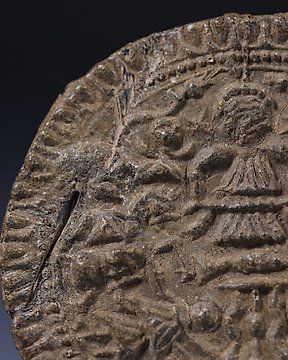
Romain antique Plomb plaque rare - 7 cm
Nº 83736729

Nº 83736729

ITEM: Sling bullet with inscription 'CN MAG’, Gnaeus Pompeius
MATERIAL: Lead
CULTURE: Roman
PERIOD: 45 B.C
DIMENSIONS: 18 mm x 38 mm
CONDITION: Good condition
PROVENANCE: Ex English private collection, M. C., acquired in 1990s
Comes with Certificate of Authenticity and Export license
Sling, implement for propelling missiles, one of the first missile weapons used in warfare. It consisted of a small strap or socket of leather to which two cords were attached. The warrior, or slinger, held the ends of the cords in one hand, placed the missile snugly in the strap, and whirled the socket and missile rapidly around his head; by letting go of one cord at the right moment, the slinger could let the missile fly out of the socket at a high speed.
In the Roman army of the time of the Punic Wars (3rd–2nd century BC), the slingers were auxiliaries from Greece, Syria, and Africa. The Balearic islanders who constituted a part of Hannibal’s Carthaginian army fighting the Romans were renowned as slingers.
Thanks to its inscription ‘CN MAG / IMP’, we can identify that it comes from the famous battle of Munda that on March 17, 45 B.C. decided in favour of Caesar the war against the sons of Pompey the Great, Gnaeus and Sextus
The legend CN MAG reads as Cn(aeus) Mag(nus), and refers with certainty to Gnaeus Pompeius Magnus, i.e. Pompey’s eldest son, of the same name as his father. We know that, during his stay in Hispania, he minted coins on which he was mentioned as Cnaeus Magnus Imperator.
Comment acheter sur Catawiki ?
1. Découvrez des objets d’exception
2. Faites la meilleure offre
3. Effectuez un paiement sécurisé